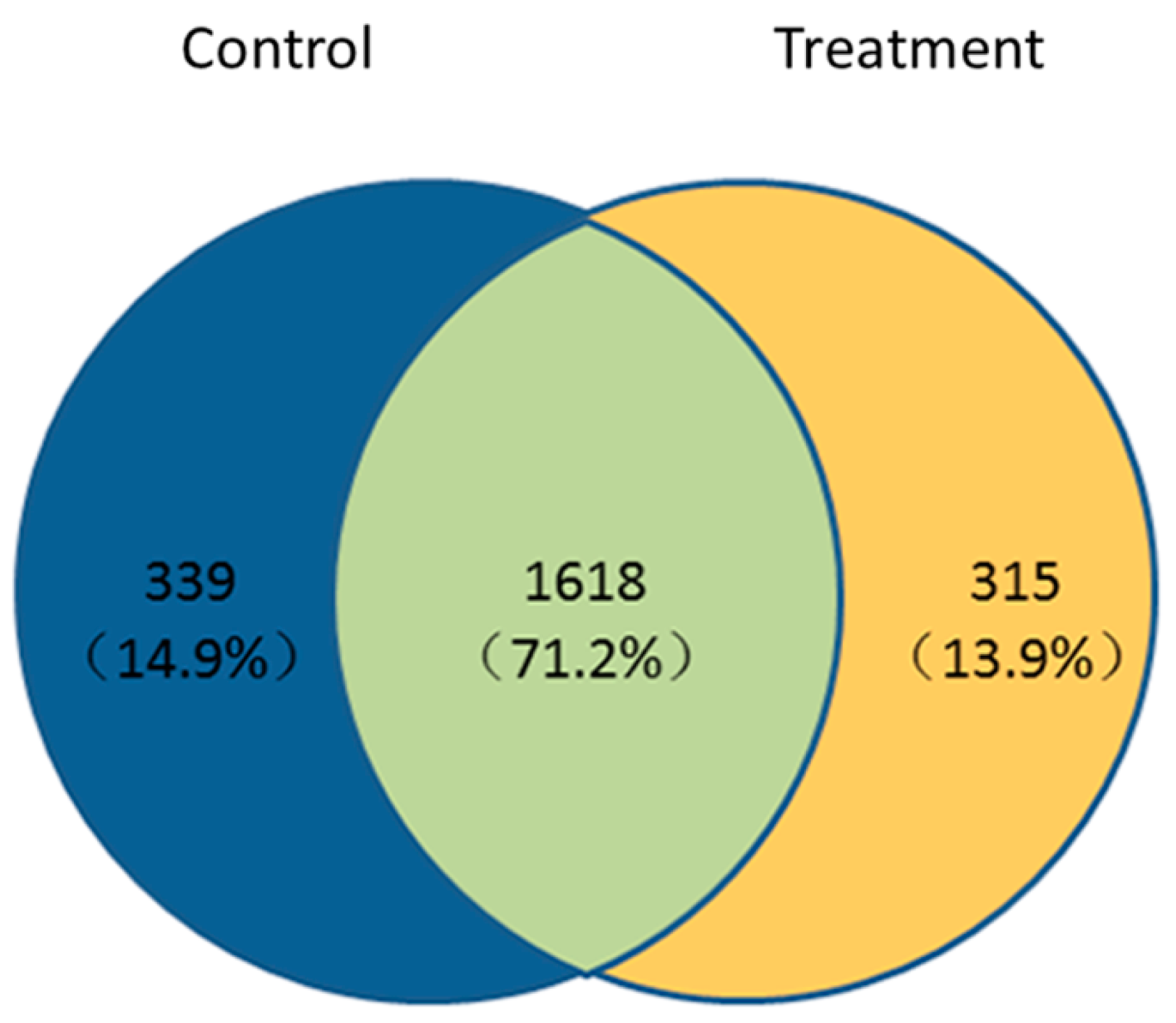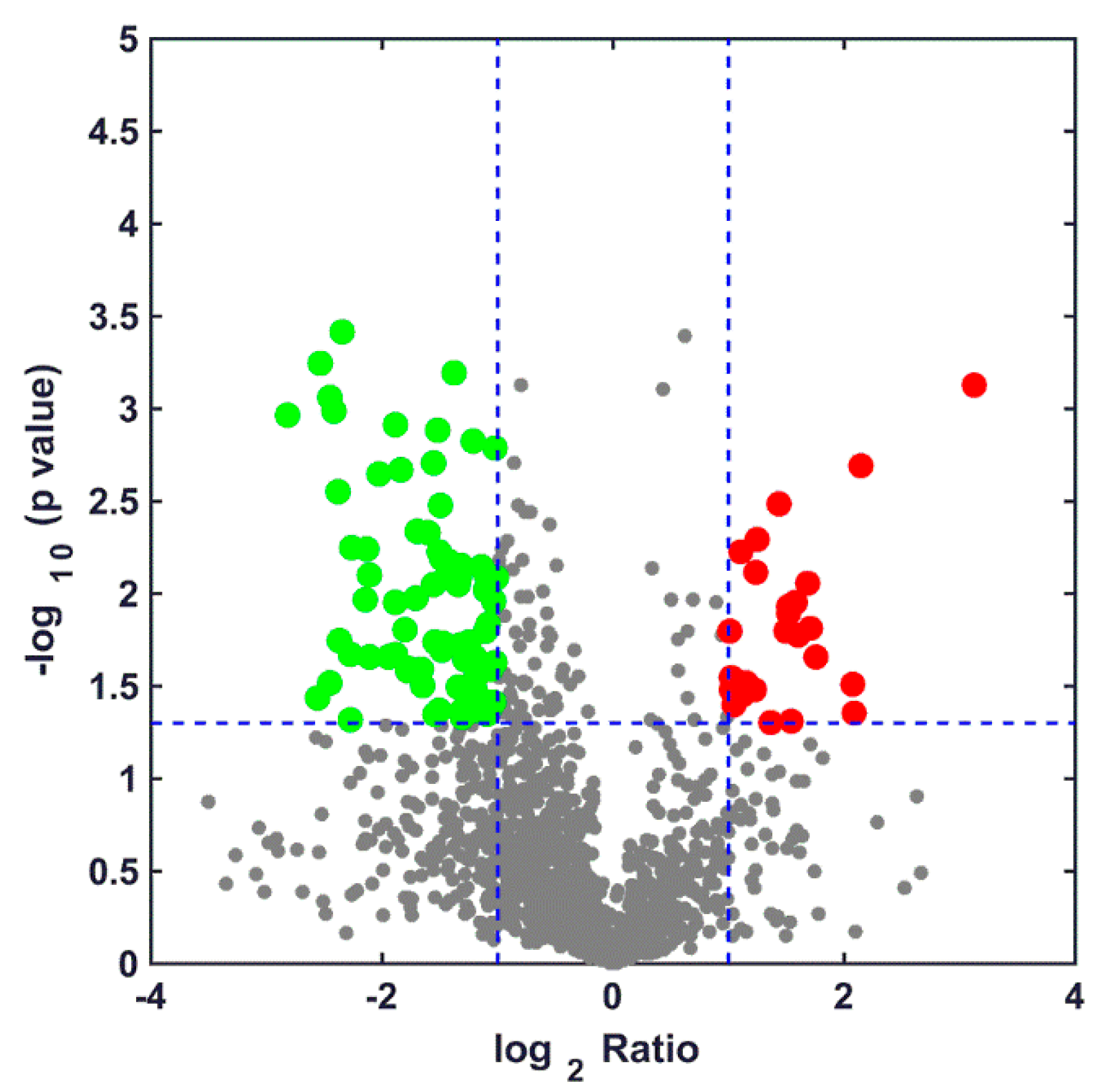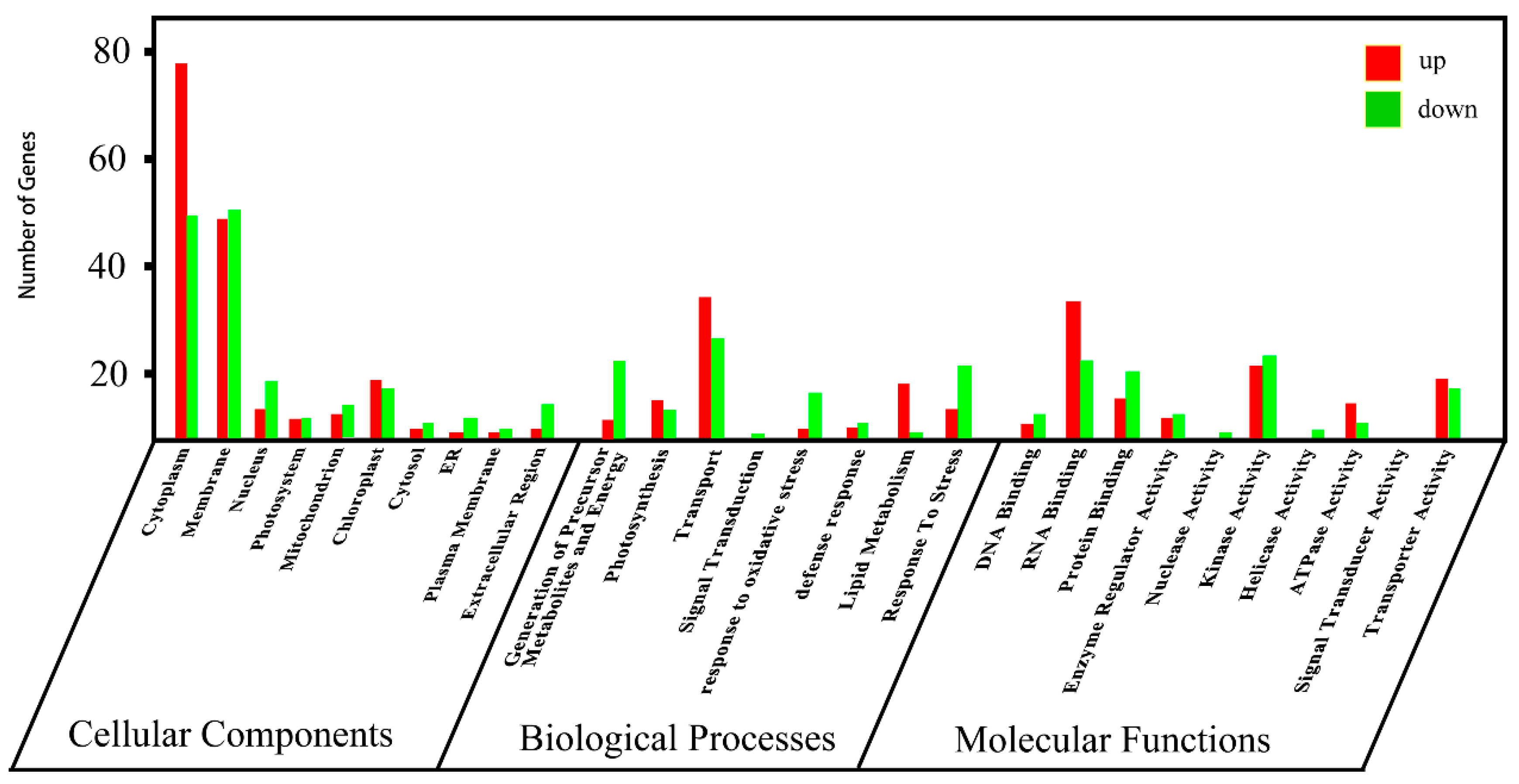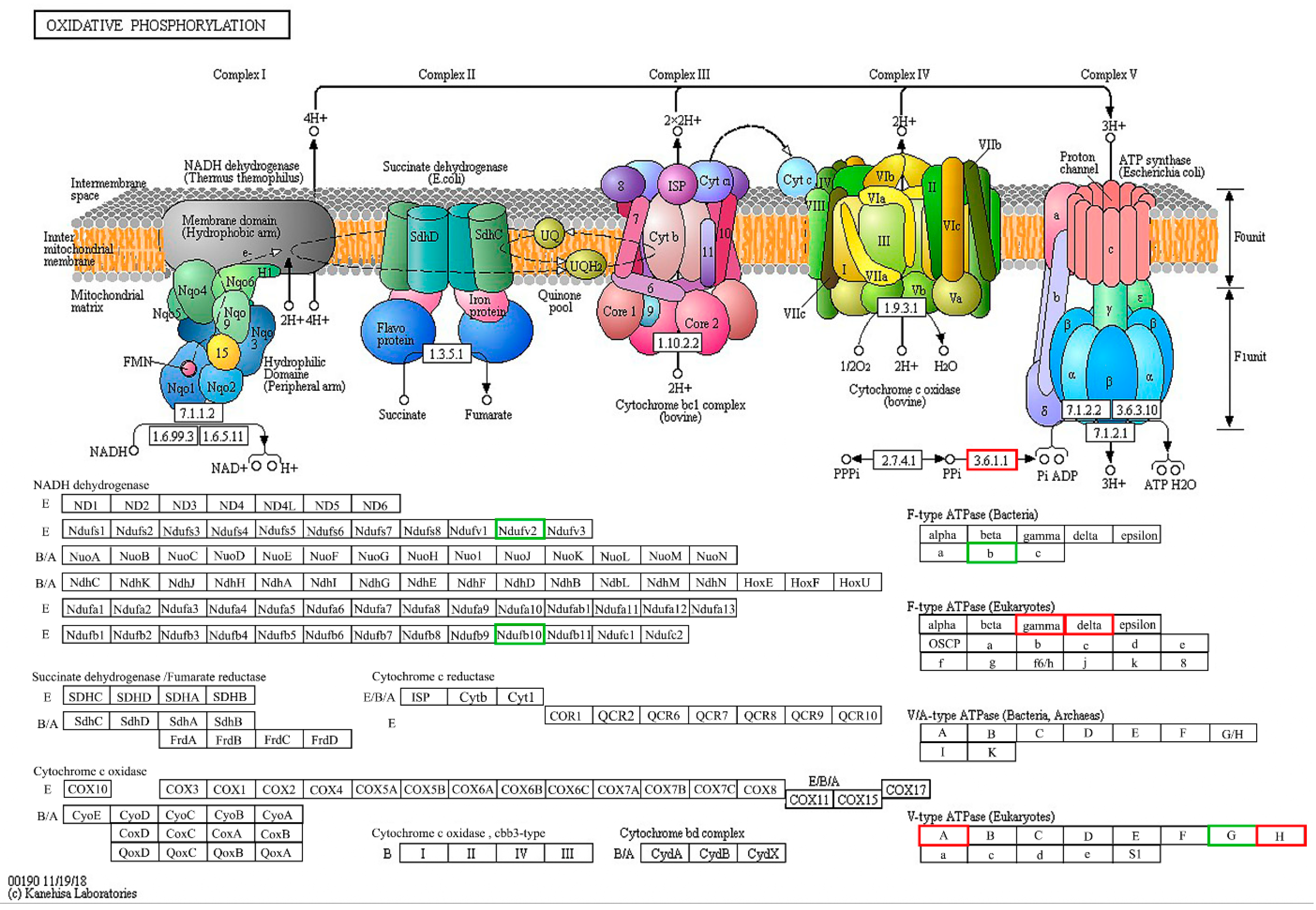Induced Resistance Mechanism of Novel Curcumin Analogs Bearing a Quinazoline Moiety to Plant Virus
Abstract
1. Introduction
2. Results
2.1. Synthesis
2.2. Antiviral Biological Assay
2.3. The Mechanism by Which Compound A13 Induces Resistance
2.3.1. Physiological and Biochemical Analysis
The Effect on Defensive Enzyme Activity
The Effect on Chlorophyll Contents
The Effect on Defense-Related Genes
2.3.2. The Proteomics Analysis of Tobacco’s Response to A13
The DEP Analysis
Differential Protein Gene Ontology (GO) Slim Analysis
Kyoto Encyclopedia of Genes and Genomes (KEGG) Pathways
3. Discussion
4. Materials and Methods
4.1. Inhibitory Activity Against TMV
4.1.1. Purification of TMV
4.1.2. The Curative Activities of the Compounds against TMV In Vivo
4.1.3. The Protective Activities of the Compounds against TMV In Vivo
4.2. Mechanism of Inducing Resistance in Plants
4.2.1. Determination of Defensive Enzyme Activities
4.2.2. Chlorophyll Content
4.2.3. Determination of the Relative Expression of Defense Genes
4.2.4. Differentially Expressed Protein Data Analysis
Tobacco Protein Extraction
LC-MS/MS Analysis
Proteomics Data Analysis
Bioinformatics and Annotations
4.2.5. Statistical Analysis
5. Conclusions
Supplementary Materials
Author Contributions
Acknowledgments
Conflicts of Interest
Abbreviations
| TMV | Tobacco mosaic virus |
| COS | Chitosan oligosaccharide |
| DEPs | Differentially expressed protein |
| KEGG | Kyoto Encyclopedia of Genes and Genomes |
References
- Lan, X.M.; Xie, D.D.; Yin, L.M.; Wang, Z.Z.; Chen, J.; Zhang, A.W.; Hu, D.Y.; Song, B.A. Novel hα, β-unsaturated amide derivatives bearing α-amino phosphonate moiety as potential antiviral agents. Bioorg. Med. Chem. Lett. 2017, 27, 4270–4273. [Google Scholar] [CrossRef] [PubMed]
- Panattoni, A.; Luvisi, A.; Triolo, E. Selective chemotherapy on Grapevine leafroll-associated virus-1 and -3. Phytoparasitica 2011, 39, 503–508. [Google Scholar] [CrossRef]
- Silva, N.L.; Zobiole, N.N.; Brentan da Silva, D.; Sartori, A.L.B.; Oliveira, R.J.; Pinto, M.E.A.; Leite dos Santos, F.J.; Maximo de Siqueira, J. Chemical constituents and phytotoxic activity of leaves of Annona nutans. Quim Nova. 2015, 38, 640–644. [Google Scholar] [CrossRef]
- Gozzo, F.; Faoro, F. Systemic Acquired Resistance (50 Years after Discovery): Moving from the Lab to the Field. J. Agric. Food. Chem. 2013, 61, 12473–12491. [Google Scholar] [CrossRef] [PubMed]
- Fan, H.T.; Song, B.A.; Bhadury, P.S.; Jin, L.H.; Hu, D.Y.; Yang, S. Antiviral activity and mechanism of action of novel thiourea containing chiral phosphonate on tobacco mosaic virus. Int. J. Mol. Sci. 2011, 12, 4522–4535. [Google Scholar] [CrossRef] [PubMed]
- Kim, Y.; Komoda, E.; Miyashita, E.; Miyagawa, H. Continuous stimulation of the plant immune system by the peptide elicitor PIP-1 is required for phytoalexin biosynthesis in tobacco cells. J. Agric. Food. Chem. 2014, 62, 5781–5788. [Google Scholar] [CrossRef] [PubMed]
- Jones, J.D.; Dangl, J.L. The plant immune system. Nature 2006, 444, 323–329. [Google Scholar] [CrossRef]
- Du, Q.S.; Zhu, W.P.; Zhao, Z.J.; Qian, X.H.; Xu, Y.F. Novel benzo-1,2,3-thiadiazole-7-carboxylate derivatives as plant activators and the development of their agricultural applications. J. Agric. Food. Chem. 2012, 60, 346–353. [Google Scholar] [CrossRef]
- Tsuda, K.; Katagiri, F. Comparing signaling mechanisms engaged in patterntriggered and effector-triggered immunity. Curr. Opin. Plant Biol. 2010, 13, 459–465. [Google Scholar] [CrossRef]
- Kawai, T.; Akira, S. The role of pattern-recognition receptors in innate immunity: Update on Toll-like receptors. Nat. Immunol. 2010, 11, 373–384. [Google Scholar] [CrossRef]
- Schreiber, K.; Desveaux, D. Message in a bottle: Chemical biology of induced disease resistance in plants. Plant Pathology J. 2008, 24, 245–268. [Google Scholar] [CrossRef]
- Noutoshi, Y.; Jikumaru, Y.; Kamiya, Y.; Shirasu, K. ImprimatinC1, a novel plant immune-priming compound, functions as a partial agonist of SA. Sci. Rep. 2012, 2, 705–712. [Google Scholar] [CrossRef] [PubMed]
- Ryan, A.C. Oligosaccharide signals: From plant defense to parasite offense. Proc. Natl. Acad. Sci. USA 1994, 97, 1–2. [Google Scholar] [CrossRef]
- Mathieu, Y.; Kurkdjian, A.; Xia, H.; Guern, J.; Keller, A.; Spiro, M.D.; Albersheim, P.; Darvill, A. Membrane responses induced by oligogalacturonides in suspension-cultured tobacco cells. Plant. J. 1991, 1, 333–343. [Google Scholar] [CrossRef] [PubMed]
- Nürnberger, T.; Nennstiel, D.; Jabs, J.; Sacks, W.R.; Hahlbrock, K.; Scheel, D. High affinity binding of a fungal oligopeptide elicitor to parsley plasma membranes triggers multiple defense responses. Cell 1994, 78, 449–460. [Google Scholar] [CrossRef]
- Yin, H.; Zhao, X.; Du, Y. Oligochitosan: A plant diseases vaccine—A review. Carbohydr. Polym. 2010, 82, 1–8. [Google Scholar] [CrossRef]
- Zhao, X.M.; She, X.P.; Du, Y.G.; Liang, X.M. Induction of antiviral resistance and stimulatory effect by oligochitosan in tobacco. Pestici. Biochem. Phys. 2007, 87, 78–84. [Google Scholar] [CrossRef]
- Fan, Z.J.; Shi, Z.G.; Zhang, H.K.; Liu, X.F.; Bao, L.L.; Ma, L.; Zuo, X.; Zheng, Q.X.; Mi, N. Synthesis and biological activity evaluation of 1,2,3-thiadiazole derivatives as potential elicitors with highly systemic acquired resistance. J. Agric. Food. Chem. 2009, 57, 4279–4286. [Google Scholar] [CrossRef]
- Gan, X.H.; Hu, D.Y.; Wang, Y.J.; Lu, Y.; Song, B.A. Novel trans-ferulic acid derivatives containing a chalcone moiety as potential activator for plant resistance induction. J. Agric. Food Chem. 2017, 65, 4367–4377. [Google Scholar] [CrossRef]
- Gan, X.H.; Hu, D.Y.; Li, P.; Wu, J.; Chen, X.W.; Xue, W.; Song, B.A. Design, synthesis, antiviral activity, and three-dimensional quantitative structure-activity relationship study of novel1,4-pentadien-3-one derivatives containing the 1,3,4-oxadiazole moiety. Pest. Manag. Sci. 2015, 72, 534–543. [Google Scholar] [CrossRef]
- Ma, J.; Li, P.; Li, X.; Shi, Q.; Wan, Z.; Hu, D.Y.; Jin, L.H.; Song, B.A. Synthesis and antiviral bioactivity of novel 3-((2-((1E, 4E)-3-oxo-5-arylpenta-1, 4-dien-1-yl) phenoxy) methyl)-4 (3 H)-quinazolinone derivatives. J. Agric. Food. Chem. 2014, 62, 8928–8934. [Google Scholar] [CrossRef] [PubMed]
- Luo, H.; Liu, J.; Jin, L.; Hu, D.Y.; Chen, Z.; Yang, S.; Wu, J.; Song, B.A. Synthesis and antiviral bioactivity of novel (1E, 4E)-1-aryl-5-(2-(quinazolin-4-yloxy) phenyl)-1, 4-pentadien-3-one derivatives. Eur. J. Med. Chem. 2013, 63, 662–669. [Google Scholar] [CrossRef] [PubMed]
- Luo, H.; Hu, D.Y.; Wu, J.; He, M.H.; Jin, L.H.; Yang, S.; Song, B.A. Rapid synthesis and antiviral activity of (quinazolin-4-ylamino) methyl-phosphonates through microwave irradiation. Int. J. Mol. Sci. 2012, 13, 6730–6746. [Google Scholar] [CrossRef] [PubMed]
- Xie, D.D.; Shi, J.; Zhang, A.W.; Zu, G.C.; Fu, Y.; Gan, X.H.; Yin, L.M.; Song, B.A.; Hu, D.Y. Syntheses, antiviral activities and induced resistance mechanisms of novel quinazoline derivatives containing a dithioacetal moiety. Bioorg. Chem. 2018, 80, 433–443. [Google Scholar] [CrossRef]
- Long, C.W.; Li, P.; Chen, M.H.; Dong, L.R.; Hu, D.Y.; Song, B.A. Synthesis, anti-tobacco mosaic virus and cucumber mosaic virus activity, and 3D-QSAR study of novel 1,4-pentadien-3-one derivatives containing 4-thioquinazoline moiety. Eur. J. Med. Chem. 2012, 102, 639–647. [Google Scholar] [CrossRef] [PubMed]
- Chen, M.H.; Chen, Z.; Song, B.A.; Bhadury, P.S.; Yang, S.; Cai, J.X.; Hu, D.Y.; Xue, W.; Zeng, S. Synthesis and antiviral activities of chiral thiourea derivatives containing an R-aminophosphonate moiety. J. Agric. Food. Chem. 2009, 57, 1383–1388. [Google Scholar] [CrossRef] [PubMed]
- Dietz, K.J.; Turkan, I.; Krieger-Liszkay, A. Redox- and reactive oxygen species-dependent signaling into and out of the photosynthesizing chloroplast. Plant Physiol. 2016, 171, 1541–1550. [Google Scholar] [CrossRef]
- Nicholson, R.L.; Hammerschmidt, R.R. Phenolic compounds and their role in disease resistance. Annu. Rev. Phytopathol. 1992, 30, 369–389. [Google Scholar] [CrossRef]
- Jiang, Y.F.; Du, Z.Y.; Xue, G.H.; Chen, Q.; Lu, Y.J.; Zheng, X.; Conney, A.H.; Zhang, K. Synthesis and biological evaluation of unsymmetrical curcumin analogues as tyrosinase inhibitors. Molecules 2013, 18, 3948–3961. [Google Scholar] [CrossRef]
- Ahmad, I.; Cheng, Z.H.; Meng, H.W.; Liu, T.J.; Nan, W.C.; Khan, M.A.; Wasila, A.R.; Khan, H. Effect of intercropped garlic (Allium sativum) on chlorophyl contents, photosynthesis and antioxidant enzymes in pepper. Pak. J. Bot. 2013, 45, 1889–1896. [Google Scholar]
- Ashburner, M.; Ball, C.A.; Blake, J.A.; Botstein, D.; Butler, H.; Cherry, J.M.; Davis, J.M.A.P.; Dolinski, K.; Dwight, S.S.; Eppig, J.T.; et al. Gene ontology: Tool for the unification of biology. Nat. Genet. 2000, 25, 25–29. [Google Scholar] [CrossRef] [PubMed]
- Jiao, W.X.; Li, X.X.; Cao, J.K. Chlorogenic acid induces resistance against Penicillium expansum in peach fruit by activating the salicylic acid signaling pathway. Food Chem. 2018, 260, 274–282. [Google Scholar] [CrossRef] [PubMed]
- An, C.F.; Mou, Z.L. Salicylic acid and its function in plant immunity. J. Integr. Plant Biol. 2011, 53, 412–428. [Google Scholar] [CrossRef] [PubMed]
- Meng, X.; Xu, J.; He, Y.; Yang, K.K.; Mordorski, B.; Liu, Y.; Zhang, S.Q. Phosphorylation of an ERF transcription factor by Arabidopsis MPK3/MPK6 regulates plant defense gene induction and fungal resistance. Plant Cell. 2013, 25, 1126–1142. [Google Scholar] [CrossRef] [PubMed]
- Cao, H.; Glazebrook, J.; Clarke, J.D.; Volko, S.; Dong, X.N. Thearabidopsis NPR1 gene that controls systemic acquired resistance encodes a novel protein containing ankyrin repeats. Cell 1997, 88, 57–63. [Google Scholar] [CrossRef]
- Niki, T.; Mitsuhara, I.; Seo, S.; Ohtsubo, N.; Ohashi, Y. Antagonistic effect of SA and jasmonic acid on the expression of pathogenesis-related (PR) protein genes in wounded mature tobacco leaves. Plant Cell Physiol. 1998, 39, 500–507. [Google Scholar] [CrossRef]
- Zhang, Y.; Xu, S.; Ding, P.; Wang, D.; Cheng, Y.T.; He, J.; Gao, M.H.; Xu, F.; Zhu, Z.H.; Li, X. Control of SA synthesis and systemic acquired resistance by two members of a plant-specific family of transcription factors. Proc. Natl. Acad. Sci. USA 2010, 107, 18220–18225. [Google Scholar] [CrossRef]
- Falk, A.; Feys, B.J.; Frost, L.N.; Jones, J.D.; Daniels, M.J.; Parker, J.E. EDS1, an essential component of R gene-mediated disease resistance in Arabidopsis has homology to eukaryotic lipases. Proc. Natl. Acad. Sci. USA 1999, 96, 3292–3297. [Google Scholar] [CrossRef]
- Lu, P.L.; Ma, D.; Yan, C.Y.; Gong, X.Q.; Du, M.Q.; Shi, Y.G. Structure and mechanism of a eukaryotic transmembrane ascorbate-dependent oxidoreductase. Proc. Natl. Acad. Sci. USA 2014, 111, 1813–1818. [Google Scholar] [CrossRef]
- Cooperman, B.S.; Baykov, A.A.; Lahti, R. Evolutionary conservation of the active site of soluble inorganic pyrophosphatase. Trends Biochem. Sci. 1992, 17, 262–266. [Google Scholar] [CrossRef]
- Revington, M.; Dunn, S.T.; Shaw, G.S. Folding and stability of the b subunit of the F1F0 ATP synthase. Protein Sci. 2002, 11, 1227–1238. [Google Scholar] [CrossRef] [PubMed]
- Gooding, G.V.J.; Hebert, T.T. A simple technique for purification of Tobacco mosaic virus in large quantities. Phytopathology 1967, 57, 1285–1290. [Google Scholar] [PubMed]
- Yang, A.M.; Yu, L.; Chen, Z.; Zhang, S.X.; Shi, J.; Zhao, X.Z.; Yang, Y.Y.; Hu, D.Y.; Song, B.A. Label-Free Quantitative Proteomic Analysis of Chitosan Oligosaccharide-Treated Rice Infected with Southern Rice Black-Streaked Dwarf Virus. Viruses 2017, 9, 115. [Google Scholar] [CrossRef] [PubMed]
- Livak, K.J.; Schmittgen, T.D. Analysis of relative gene expression data using real-time quantitative PCR and the 2 −∆∆CT method. Methods 2001, 25, 402–408. [Google Scholar] [CrossRef] [PubMed]
- Tahara, S.T.; Mehta, A.; Rosato, Y.B. Proteins induced by Xanthomonas axonopodispv. passiflorae with leaf extract of the host plant (Passiflorae edulis). Proteomics 2003, 3, 95–102. [Google Scholar] [CrossRef]
- Cox, J.; Neuhauser, N.; Michalski, A.; Scheltema, R.A.; Olsen, J.V.; Mann, M.M. Andromeda: A peptide search engine integrated into the MaxQuant environment. J. Proteome Res. 2011, 10, 1794–1805. [Google Scholar] [CrossRef] [PubMed]
- Cox, J.; Michalski, A.; Mann, M. Software lock mass by two-dimensional minimization of peptide mass errors. J. Am. Soc. Mass Spectrom. 2011, 22, 1373–1380. [Google Scholar] [CrossRef]
- Luber, C.A.; Cox, J.; Lauterbach, H.; Fancke, B.; Selbach, M.; Tschopp, J.; Akira, S.; Wiegand, M.H.O.; Hochrein, M.; OKeeffe, M.M. Quantitative proteomics reveals subset-specific viral recognition in dendritic cells. Immunity 2010, 32, 279–289. [Google Scholar] [CrossRef]
- Gene, O.C. The gene ontology (GO) database and informatics resource. Nucleic Acids Res. 2004, 32, 258–261. [Google Scholar] [CrossRef]








| Compound | R1 | R2 | Protection Activity a (%) | Curative Activity a (%) |
|---|---|---|---|---|
| A-1 | 7-Br | 4-OCH3 | 39.7 ± 4.3 | 55.8 ± 3.7 |
| A-2 | 7-Br | 2-Cl | 37.3 ± 5.0 | 18.8 ± 7.6 |
| A-3 | 7-Br | 4-F | 50.6 ± 2.8 | 58.1 ± 10.0 |
| A-4 | 7-Br | 3,4-diOCH3 | 39.4 ± 1.9 | 20.2 ± 2.3 |
| A-5 | 7-Br | 4-CH3 | 27.4 ± 2.5 | 33.2 ± 1.9 |
| A-6 | 7-Br | 4-Br | 46.5 ± 1.6 | 32.9 ± 7.1 |
| A-7 | 7-Br | H | 17.2 ± 6.2 | 9.3 ± 5.4 |
| A-8 | 7-Br | 4-Cl | 47.3 ± 9.3 | 20.4 ± 1.7 |
| A-9 | 7-Br | 4-SCH3 | 48.8 ± 3.3 | 27.8 ± 8.0 |
| A-10 | 6-Cl | 4-SCH3 | 32.2 ± 7.2 | 34.0 ± 2.5 |
| A-11 | 6-Cl | 2,6-Cl | 38 ± 1.3 | 49.9 ± 9.6 |
| A-12 | 6-Cl | 4-Cl | 66.5 ± 3.0 | 42.0 ± 5.5 |
| A-13 | 6-Cl | 4-OCH3 | 70.4 ± 2.6 | 42.9 ± 2.2 |
| A-14 | 6-Cl | 2-Cl | 37.9 ± 5.6 | 50.8 ± 7.7 |
| A-15 | 6-Cl | 3,4-diOCH3 | 47.6 ± 9.8 | 9.4 ± 1.5 |
| A-16 | 6-Cl | 4-Br | 25.9 ± 4.2 | 38.1 ± 8.4 |
| A-17 | 6-Cl | 4-F | 32.3 ± 9.1 | 37.4 ± 6.0 |
| A-18 | 6-Cl | 4-CH3 | 41.5 ± 8.7 | 13.9 ± 3.5 |
| A-19 | 6-Cl | H | 43.6 ± 4.7 | 20.0 ± 8.3 |
| A-20 | 6-Cl | 2-F | 53.8 ± 3.0 | 21.9 ± 3.8 |
| COS b | 49.0 ± 5.9 | 34.1 ± 3.8 | ||
| ID | Protein Name | Gene Name | Regulated |
|---|---|---|---|
| Q43798 | Inorganic pyrophosphatase (EC 3.6.1.1) | Ppa | Up |
| A0A1S4DBR1 | soluble inorganic pyrophosphatase PPA1-like | Ppa1 | Up |
| A0A1S4A0E0 | ATP synthase gamma chain | ATPeF1G | Up |
| A0A1S4CSA5 | ATP synthase delta chain | ATPeF1D | Up |
| A0A097BTV9 | V-type proton ATPase catalytic subunit A | ATPeV1A | Up |
| A0A1S3Z6E6 | V-type proton ATPase subunit H-like | ATPeV1H | Up |
| A0A1S4AX40 | ATP synthase subunit b | atpF | Down |
| A0A1S4BUC0 | NADH dehydrogenase [ubiquinone] 1 beta subcomplex subunit 10-A-lik | NDUFV2 | Down |
| A0A1S4B7I9 | V-type proton ATPase subunit | ATPeV1G | Down |
| A0A1S4BUC0 | CP12 (Chloroplast protein 12) | NDUFB10 | Down |
| Q7T699 | Capsid protein, (Tobacco mosaic virus) | / | / |
| Gene Name | Forward Primer | Reverse Primer |
|---|---|---|
| ICS1 | 5′-CAGCGCTGGCCTTGGA-3′ | 5′-GGAGGTGGGTTGGATTTCAA-3′ |
| EDS1 | 5′-GGCTCGAGTATGCCCTGAAG-3′ | 5′-CTTGCCCAGAAACATGATTCC-3′ |
| SOD | 5′-CGACACTAACTTTGGCTCCCTAGA-3′ | 5′-GGTTCCTCTTCTGGGAATAGACGT-3′ |
| CAT1 | 5′-CAACTTCCTGCTAATGCTCCAA-3′ | 5′-TGCCTGTCTGGTGTGAATGA-3′ |
| PAL4 | 5′-CTCGGCCCTCAGATCGAA-3′ | 5′-CCGAGTTGATCTCCCGTTCA-3′ |
| PR1 | 5′-ATGGGATTTGTTCTCTTTTCACA-3′ | 5′-TTAGTATGGACTTTCGCCTCT-3′ |
| NPR1 | 5′-GGCGAGGAGTCCGTTCTTTAA-3′ | 5′-TCAACCAGGAATGCCACAGC-3′ |
© 2018 by the authors. Licensee MDPI, Basel, Switzerland. This article is an open access article distributed under the terms and conditions of the Creative Commons Attribution (CC BY) license (http://creativecommons.org/licenses/by/4.0/).
Share and Cite
Yin, L.; Gan, X.; Shi, J.; Zan, N.; Zhang, A.; Ren, X.; Li, M.; Xie, D.; Hu, D.; Song, B. Induced Resistance Mechanism of Novel Curcumin Analogs Bearing a Quinazoline Moiety to Plant Virus. Int. J. Mol. Sci. 2018, 19, 4065. https://doi.org/10.3390/ijms19124065
Yin L, Gan X, Shi J, Zan N, Zhang A, Ren X, Li M, Xie D, Hu D, Song B. Induced Resistance Mechanism of Novel Curcumin Analogs Bearing a Quinazoline Moiety to Plant Virus. International Journal of Molecular Sciences. 2018; 19(12):4065. https://doi.org/10.3390/ijms19124065
Chicago/Turabian StyleYin, Limin, Xiuhai Gan, Jing Shi, Ningning Zan, Awei Zhang, Xiaoli Ren, Miao Li, Dandan Xie, Deyu Hu, and Baoan Song. 2018. "Induced Resistance Mechanism of Novel Curcumin Analogs Bearing a Quinazoline Moiety to Plant Virus" International Journal of Molecular Sciences 19, no. 12: 4065. https://doi.org/10.3390/ijms19124065
APA StyleYin, L., Gan, X., Shi, J., Zan, N., Zhang, A., Ren, X., Li, M., Xie, D., Hu, D., & Song, B. (2018). Induced Resistance Mechanism of Novel Curcumin Analogs Bearing a Quinazoline Moiety to Plant Virus. International Journal of Molecular Sciences, 19(12), 4065. https://doi.org/10.3390/ijms19124065






